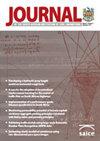The status of water for firefighting in South Africa
IF 0.6
4区 工程技术
Q4 ENGINEERING, CIVIL
Journal of the South African Institution of Civil Engineering
Pub Date : 2023-10-04
DOI:10.17159/2309-8775/2023/v65n3a2
引用次数: 0
Abstract
It is mandatory in South Africa that water for firefighting is included in the demand estimates input when designing municipal water networks. To this end, guidelines for determining fire flows for different risk categories have been developed. The most commonly used guidelines are the South African National Standard (SANS) 10090 of 2018 and the Department of Human Settlements (DHS) guide of 2019 (also called the Red Book). The evolution of the built environment, firefighting technologies and approaches, and the availability of freshwater resources all require that the fire flows in the guidelines are current and adequately protect communities from the devastating impacts of fires - this while conserving depleting freshwater resources and contributing to optimal water network design. Currently, empirical research into the appropriateness of the fire flows in SANS 10090 and the Red Book to firefighting efforts in South African municipalities is limited. This paper therefore compares water for firefighting in these two guidelines with some international companions and local firefighting data, and also compares similar data from the six studies published on this topic in South Africa. Some highlights from this investigation include: (i) the fire risk categories and fire flows in SANS 10090 and the Red Book are misaligned, and are contradictory in at least one instance; (ii) when compared with firefighting data, the fire flows in SANS 10090 and the Red Book are conservative; (iii) a significant percentage of fires were extinguished between 30 and 120 minutes; (iv) 10 kl or less of water was employed to extinguish more than 87% of fires; and (v) the frequencies of fires were positively related to dry and/or cold weather conditions.南非消防用水状况
在南非,在设计市政供水网络时,消防用水必须包含在需求估算输入中。为此目的,制定了确定不同风险类别的火灾流量的准则。最常用的指南是2018年的南非国家标准(SANS) 10090和2019年的人类住区部(DHS)指南(也称为红皮书)。建筑环境的发展、消防技术和方法以及淡水资源的可用性都要求指南中的消防流是最新的,并充分保护社区免受火灾的破坏性影响,同时保护耗尽的淡水资源并促进最佳水网设计。目前,关于SANS 10090和红皮书中火灾流对南非市政消防工作的适当性的实证研究是有限的。因此,本文将这两份指南中的消防用水与一些国际伙伴和当地消防数据进行了比较,并比较了南非就此主题发表的六项研究的类似数据。本调查的一些亮点包括:(i) SANS 10090和红皮书中的火灾风险类别和火灾流不一致,并且至少在一个实例中存在矛盾;(ii)与消防数据相比,SANS 10090和红皮书中的火流是保守的;(iii)相当大比例的火灾在30至120分钟内被扑灭;(iv)灭火用水量不超过10千升(kl);(v)火灾的频率与干燥和/或寒冷的天气条件呈正相关。
本文章由计算机程序翻译,如有差异,请以英文原文为准。
求助全文
约1分钟内获得全文
求助全文
来源期刊
CiteScore
0.70
自引率
25.00%
发文量
19
审稿时长
>12 weeks
期刊介绍:
The Journal of the South African Institution of Civil Engineering publishes peer reviewed papers on all aspects of Civil Engineering relevant to Africa. It is an open access, ISI accredited journal, providing authoritative information not only on current developments, but also – through its back issues – giving access to data on established practices and the construction of existing infrastructure. It is published quarterly and is controlled by a Journal Editorial Panel.
The forerunner of the South African Institution of Civil Engineering was established in 1903 as a learned society aiming to develop technology and to share knowledge for the development of the day. The minutes of the proceedings of the then Cape Society of Civil Engineers mainly contained technical papers presented at the Society''s meetings. Since then, and throughout its long history, during which time it has undergone several name changes, the organisation has continued to publish technical papers in its monthly publication (magazine), until 1993 when it created a separate journal for the publication of technical papers.

 求助内容:
求助内容: 应助结果提醒方式:
应助结果提醒方式:


